West and Central Turkey
Mosques, churches, synagogues and temples
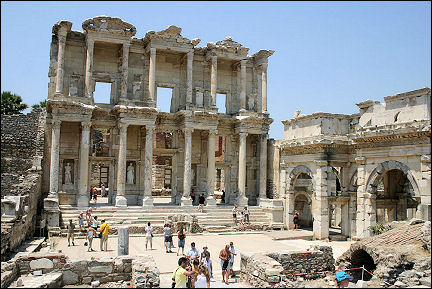
|
The variety of houses of prayer in Asia Minor reflects the history of this region on the frontier of East and West: mosques, churches, synagogues and Greek and Roman temples. The trip goes via Romenia and Bulgaria to Istanbul, Izmir, Efeze (Ephesus), Sardis and Ankara. And on the way back via Macedonia and Croatia.
Travelogue & photos: Manja Ressler
After the garage okayed the long trip for my little old car, we leave Amsterdam, planning to reach Istanbul in four days. We reach Linz, Austria in the evening and find a comfortable hotel in the town center. A short stroll confirms my first impression: a petty bourgeois town, very Austrian.
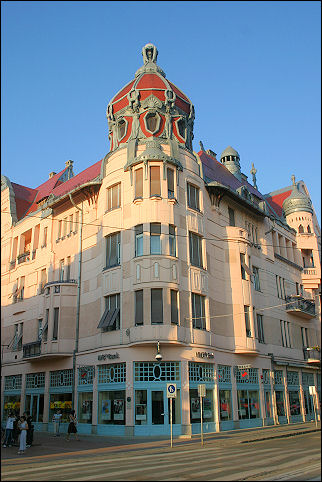
|
The next day, we cross Hungary, driving between sunflower fields that stretch all the way to the horizon with their golden glow. The villages we pass by on our way, look much better than they did twenty years ago, when I was bicycling here. But they still love their storks: every hamlet has at least one stork nest, on long poles that were erected especially for these birds.
In the afternoon, we reach our destination for today, the town of Szeged in the South. The reason I'd picked this town, is the well-kept secret of its beauty. Szeged was flooded in the first decade of the 20th century and, for the first time in European history, other countries in Europe pledged money and support to rebuild the city.
As the fashion of the day was Art Nouveau/Jugendstil at the time, most buildings were designed in that style.
Romenia and Bulgaria
The road is more pothole than asphalt as a herd of horses appears
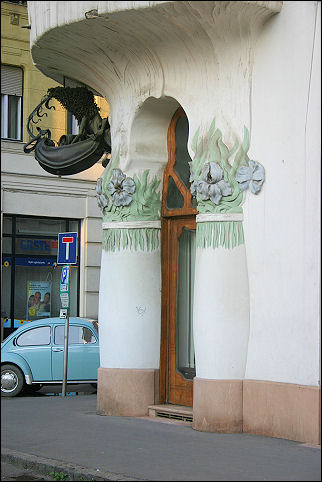
|
At the Hungarian-Romanian border the next morning, we have to drive the car through a puddle of disinfectant - something to do with bird flu.
Once we're in Romania, driving fast becomes impossible: bad roads and only two lanes. But, worst of all, nobody seems to understand how dangerous overtaking is under these circumstances. More than once, cars come directly at us, only getting back in their lane at the very last second.
But Romania is beautiful. The Carpathian Mountains are everything you think when you hear the name. Well, maybe autumn or winter is a better time to appreciate the gloomy hulkiness of rocks that rise hundreds of meters above the road.
Because we have to be in Istanbul to meet our friends in little more than a day, we have to skip a visit to Dracula's castle. We don't have time to see Bra ov or Sibiu either, both old and interesting Carpathian cities. We end up spending the night in a brand new motel.
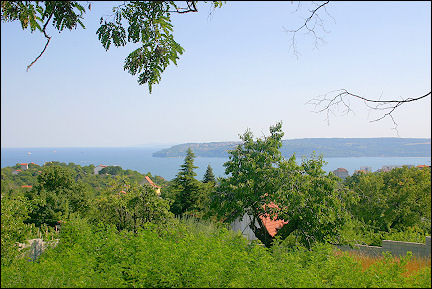
|
On the last day of our Amsterdam-Istanbul rally we drive towards Constan a and then follow the Black Sea coast almost all the way to Turkey.
The view is wonderful: on our right side, once we enter Bulgaria, green hills and on our left the sea and towns overlooking gorgeous bays.
We have dinner in a local restaurant in one of the hamlets we pass on the way to the Turkish border. The first waitress doesn't understand English, but she brings a colleague, who is learning English in school and happy to be able to use it. The owner, a sturdy, middle-aged woman, serves us delicious salads with Bulgarian white cheese.
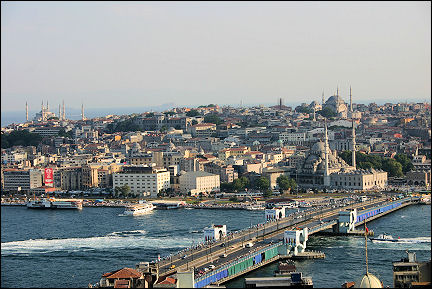
|
It's only a short while now before we will reach the border. Or so we think. When a road sign tells us to turn right, we do so, but after a few hundred meters we are convinced that this must be wrong: the road is more potholes than asphalt.
So we turn and drive back to the nearest village. Finally we find a woman, who is sitting in front of her house. Yes, the road we were on is really the road to the border. But it gets better, she promises. It doesn't, we'll find out.
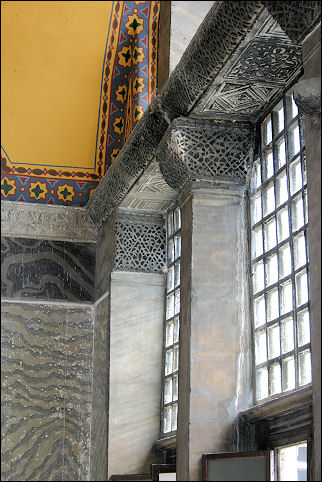
|
Meanwhile it is dark. The collection of potholes leads through a forest. There are no street lights, so I switch on my bright headlights. Inching forward, we all of a sudden see a fox in the headlights. A little later hedgehogs and frogs cross our path.
After what seems another hour, something astonishing happens: a herd of wild horses appears, seven or eight and a foal. They run nervously from side to side, not knowing how to deal with the light. When I switch off the lights for a second and then switch them back on, we can see them disappearing between the trees. They must have escaped at some point, because there are no "real" wild horses in Romania, as far as I know.
Hours later, around midnight, we finally reach the border. It takes a while before we can continue on our way, because we need to get visas and I need to fill out some forms regarding my car.
The roads in Turkey are much better than those in both Bulgaria and Romania. Still it takes us hours to get to Istanbul. In Istanbul it takes us a while to find the hotel; we drive through quiet streets and admire the illuminated Aya Sofia and the Topkapi Palace.
Istanbul
A Boat trip on the Golden Horn and the Bosphorus
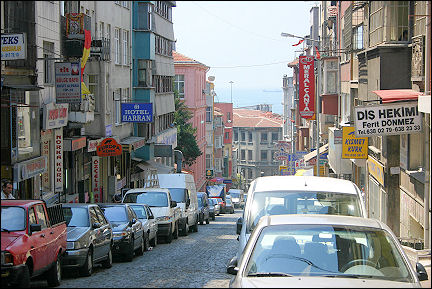
|
Next morning when I wake up, my friends have already left. So I leave the hotel - which is in the center, near the famous sights, which are concentrated in the part of the city that is called Eminönü. I don't have a map and decide to walk towards the waterfront, always a good start.
Fishing boats are floating on the calm Sea of Marmara. I don't get the opportunity to gaze and dream away, though. One waiter after another approaches me with an invitation to have a drink in his restaurant. I'm the only tourist here at the moment, so I don't blame them.
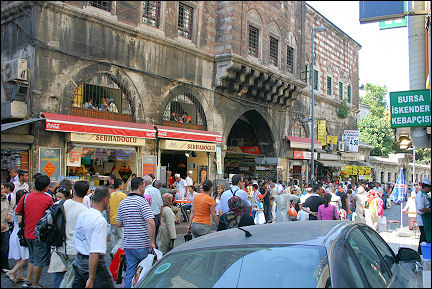
|
As I walk eastward, minarets become visible above and between other buildings. I cross the street, back into town. Within minutes I arrive at the Blue Mosque (Sultan Ahmed Mosque) and the Hippodrome in front of it.
The Hippodrome was built by the Roman Emperor Septimus Severus in 203 A.D. It was a stadium for chariot races, wrestling, boxing, and other sports, which also served as a meeting place for politicians. The arena is over 400 meters long and 120 meters wide.
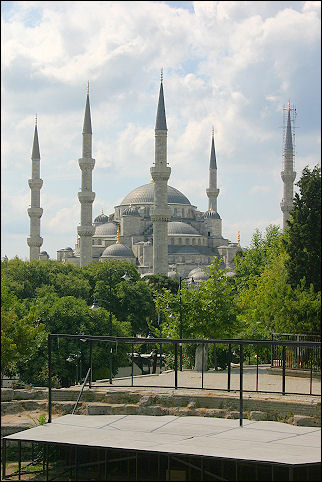
|
In the center of the hippodrome sits a tall obelisk, which originally stood in front of the temple of Karnak in Heliopolis in Egypt. It was erected by Tutmosis III (1504-1450 B.C.). Emperor Theodosius I brought the 27 meters tall pink granite obelisk, of which today only remain 17 meters, to Istanbul in 390 A.D. The hieroglyphic inscriptions on the obelisk describe the victory of the pharaoh and a sacrifice to the sun god Amon-Ra.
The Blue Mosque is surrounded by a beautiful park where thousands of people, tourists as well as worshippers, stroll and admire the enormous building with its six minarets. The Blue Mosque was founded by Sultan Ahmet I. Construction was completed in 1616.
Wandering around, I am approached by a short man, who tells me I can only visit the mosque before and after prayers.
Since Muslims pray five times a day, it's hard to plan visits to mosques. In any case, right now there's a prayer service, so he leads me around the building, showing me where the stables were and other interesting facts, but little by little it becomes clear that he owns a carpet store and would like to sell me a carpet.
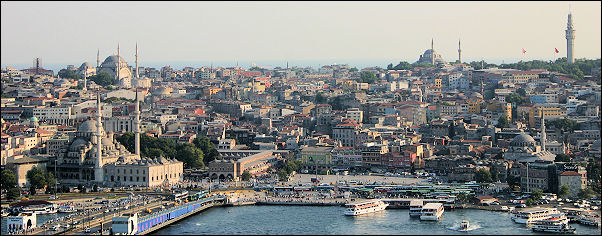
Despite my polite attempts at convincing him that I don't need a carpet right now, he succeeds in leading me to his store - where I find out that he also has a leather business. Okay, now I can ask him for his business card without feeling like a cheat, because I really would like to buy a nice leather jacket. Just not now
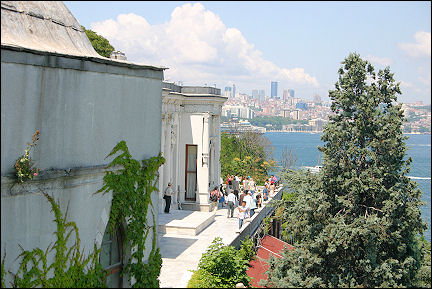
|
After refusing his invitation to have tea with him in the store as politely as possible, I'm free again and walk in the direction of the hotel.
Avoiding getting into other conversations with carpet salesmen, I walk on Divan Yolu Street, admiring mosques and other old buildings, when I run into Steve.
A little later, back in the hotel, our other friends arrive and we go out for lunch. We go to a place on the Galata Bridge, which has terraces at water level, where they had lunch yesterday. The food is delicious: mezze (starters) are brought on a huge tray and you can choose the ones you want. We have eggplant salad, stuffed green peppers and other delicacies.
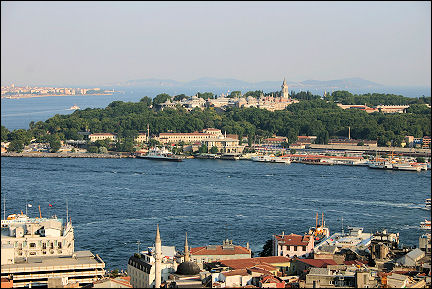
|
After lunch we cross the rest of the bridge and are now in Galata, on the other side of the Golden Horn. We climb the Galata Tower and enjoy the wonderful view of almost the whole city. The tower itself is pretty and was built in 528 by the Byzantine emperor Justitianus.
Afterwards, we walk around in Galata and discover a synagogue, completely surrounded by residential buildings. We are curious, so we walk around the block to find an entrance. When we finally find a gate that seems to give entrance to a courtyard, we are approached by a rude policeman, whose only English seems to be: "No! Only for Turkish!"
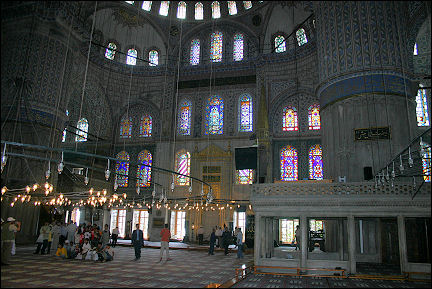
|
That is our only negative experience in this country, where people go out of their way to be friendly and helpful.
That night, because we're too tired to go out again, we have dinner on the roof of the hotel. As Steve and I are ordering Turkish wine, I tell the waiter that I'm surprised that a Muslim country produces wine. He smiles and tells us that the actual interdiction in the Quran does, at least according to his interpretation, not mean you can't drink, only that you shouldn't get drunk. The wine is good: it's light and fruity. It's a wonderful evening, the moonlights reflects in the dark Sea of Marmara, the city looks enchanted with little lights everywhere.
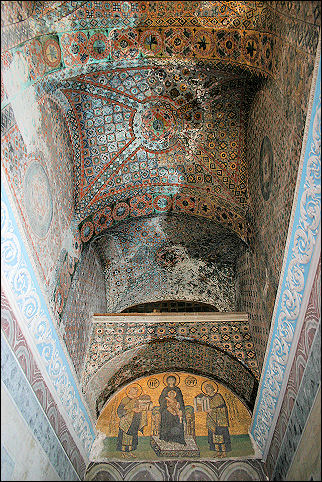
|
Next morning we set out to see the main views - this is already our last day in Istanbul. Before entering the Blue Mosque, we have to take off our shoes and I have to cover my hair and bare shoulders. The mosque is as impressive inside as from the outside: a huge vault with beautiful stained glass windows and Arabic calligraphy.
The Aya Sofia is across the street from the Blue Mosque. It originally was a church, built by the Byzantine emperor Justinian, between 532 and 537. It was converted into a mosque by Mehmet the Conqueror when he conquered Istanbul in 1453.
The building is nowadays neither church nor mosque, despite demands from vociferous Muslim groups who want it to be a mosque again.
The charm of the building, which functions as a museum, is precisely that it visibly both Christian and Muslim. Byzantine Christian frescoes exist peacefully next to abstract Muslim decorations and calligraphics.
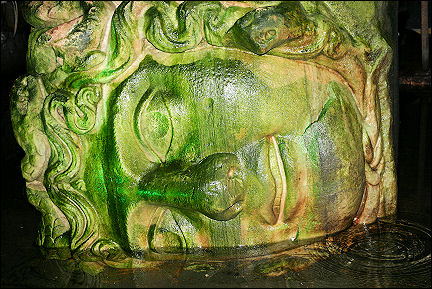
|
On our way to the next famous sight, the Topkapi Palace, we stop by the Basilica Cistern, an amazing underground construction, built in 532.
Its beauty is enhanced by sophisticated illumination and by carps and goldfish, who swim between the hundreds of columns and the big, stone Medusa heads at the end of the walkway through the cistern. I'm not surprised that it has been used as a film location.
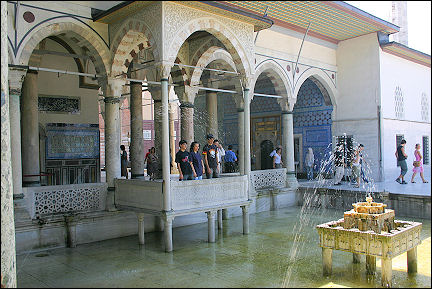
|
A little later we wander through the buildings of the Topkapi Palace, one building even more astonishing than the other. Since it was built by Mehmet II after his conquest of Constantinopel in 1453 it has been home to all Ottoman sultans.
The last sultan to live there was Abdulmecid I (1839-1860). It is located on Seraglio Point, a hill overlooking both the Sea of Marmara and the Bosphorus.
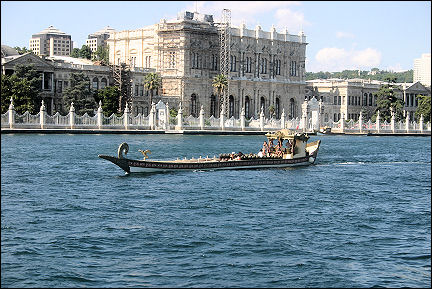
|
We walk back to the Galata Bridge, where the ferries to other parts of the city are docked. We are approached by a man who owns a small fishing boat and offers to give us a private tour of the Golden Horn and the Bosphorus for a reasonable amount of money.
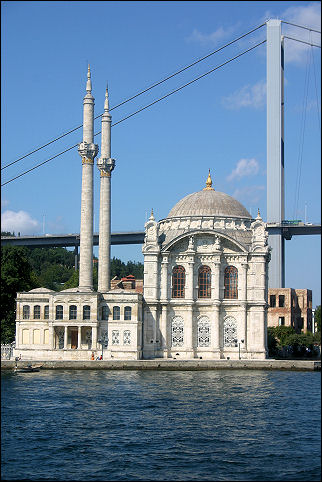
|
He sails close to the shore, so we can admire the mosques and luxurious palaces on the banks. He takes us as far as the Bosphorus Bridge, then turns and sails back along the Asian part of Istanbul. It's nice on the water, there's a little breeze that makes you forget the heat.
In the evening we attend a concert and a Whirling Ceremony by the Sufi Group of Istanbul Galata Mevlevi Lodge in the Sirkeci Train Station, where in the 20th century the famous Orient Express left for the Far East. The Sufi are a mystical Muslim sect, who seek the divine within themselves through meditation.
During the first half hour the musicians and singers perform exquisitely beautiful, dreamlike traditional Sufi music. Then the Sema begins: praises of the prophet Mohammed are recited, followed by a drum solo piece and a flute improvisation.
Then the semazens (whirling dervishes), who wear long black cloaks over their white dresses and brown pointy hats that look like supersized thimbles, take off their cloaks and one after another start whirling. Every movement and even their clothes carry symbolical meaning. It is beautiful and strangely moving.
Afterward, we walk around looking for a place to eat. Unfortunately, that night there is a soccer match on television and virtually every restaurant has a huge screen outside. Finally we find one without television and, as it turns out, great food. I have spicy meatballs with roasted eggplant.
Izmir
Along green hills, mountains and olive groves
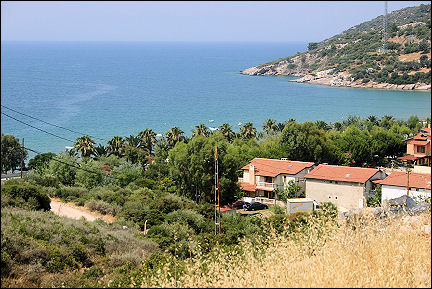
|
Early next morning Steve and I leave Istanbul by car; our two other friends take a plane. We're going to visit Izmir (Smyrna), a port town on the Aegean Sea.
It's a wonderful trip along green hills, mountains and olive groves. And every now and then there's a panoramic view of the Aegean See and the coastline, which curves itself around the sea.
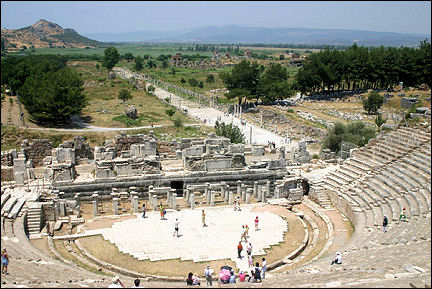
|
We have lunch in a road side restaurant that in no way resembles what we are familiar with in Western Europe and America: it's a real restaurant that serves real food. The grilled liver is delicious.
Izmir is a modern city, not overly interesting, but at night the illuminated citadel on a hill makes up for everything. There is a full moon, as we discover while we're having dinner on the waterfront.
Efeze (Ephesus)
A real city, with a theatre, streets and buildings
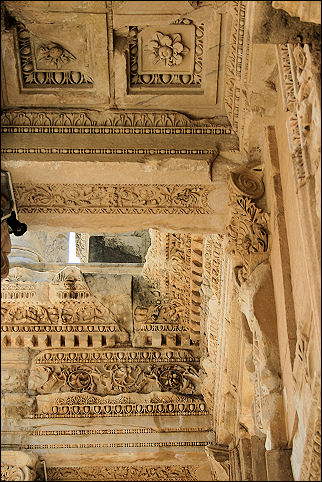
|
Today the four of us drive to Ephesus, an archeological site near the town of Selçuk, over 70 km from Izmir. Ephesus is the best preserved ancient Greek city in Asia Minor. It was founded between 1000 and 1500 B.C. and was destroyed and rebuilt several times.
Ephesos is an overwhelming experience: it's a real city, with streets and buildings. It has a beautiful Roman theatre, which is still used for performances. There's an Artemis temple - one of the Seven Wonders of the World - and a library from the Roman period, the Celsus library, with Greek and Latin inscriptions.
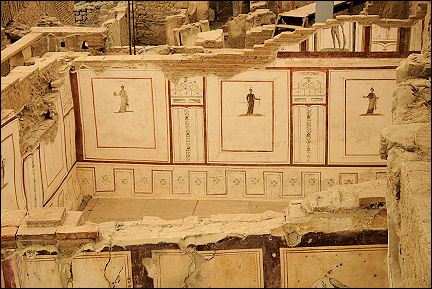
|
There is a covered complex of six apartements, for which an extra entrance fee is required. But it's worth it, it has stunning mosaics - I loved the one with the lion - and frescoes.
One apartment has frescoes of women dressed in different fashionable Roman dresses of the period.
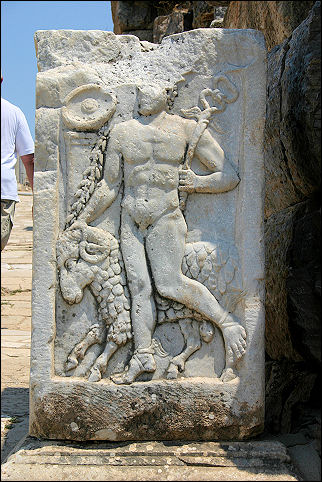
|
Next morning our friends fly back to Amsterdam from Izmir. While wandering through the bazar, looking for a camera store, we are approached by an elderly, somewhat unkempt man who takes us to a camera store. We thank him and want to give him some money, but he tells us to come with him.
He takes us to an old caravanserai, which now houses all kinds of stores. And then he shows us a 450 years old mosque. We are invited to go inside and can take as many pictures as we like. The custodian offers us... carpets. Old ones, from the mosque, he says. There is a group of children in the mosque; officially they have Quran class, but they are running around and having fun.
Sardis
Shops, a forum and a first century synagogue
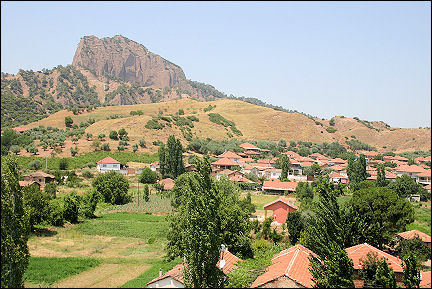
|
We leave Izmir and drive to the ancient city of Sardis, near the town of Salihli. First we visit the nearby Artemis temple, a huge structure, and even though only a few columns are still complete, it's very impressive.
And it's quiet. Yesterday, in Ephesos, there were thousands of tourists, but here we're the only ones. The surrounding hills and the horse and donkey that graze between the ruins, add to the extraordinary experience.
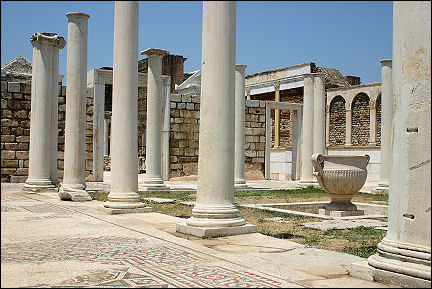
|
In Sardis it is the same: hardly anyone there, even though this is also a more than worthwhile archeological site: it's mostly Byzantine, there are streets with ruins of shops, there's a forum and there is a beautifully restored 1st century synagogue, with pretty mosaics.
We drive farther East, hoping to reach Cappadocia today. The landscape changes: from hills with olive groves and vineyards to mountains and lakes.
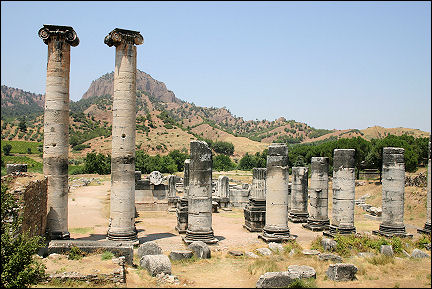
|
The farther East we get, the more often we pass by horse-drawn wagons with whole families on them. It gets later and later and we're not getting nearer, so we have to admit that this is a big country indeed and drive to Ankara instead.
Ankara
The Citadel looks like a medieval city with its high, thick walls
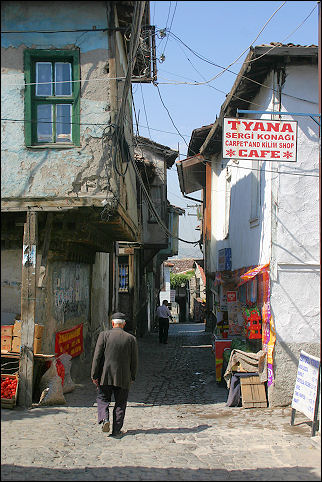
|
We find a nice and cheap hotel, where we are the only foreign guests. As luck has it, this is a neighborhood with many cafés, bars and restaurants. We find a place where we can eat outside. A few tables away from us, two man are playing music. One has an ud (looks a little like a lute) and the other plays the tabla. As the evening progresses, the men at the table get increasingly sentimental.
At breakfast next morning I feel a little uncomfortable in my tank top: the only other women in the room wear headscarves. So I'm relieved when two Turkish women, mother and daughter, enter the room in tank tops as well.
We drive to the Citadel in nightmarish traffic. Nobody cares about traffic rules, everyone constantly honks and, worst of all, people create extra lanes by pushing their cars between the official lanes. But the Citadel is easily found and is worth the unpleasant drive.
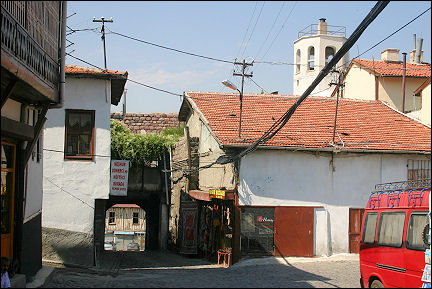
|
On a high hill overlooking Ankara, the Citadel looks like a medieval city with its high walls. Legend has it that the Citadel was built by the Hittites or by King Midas of Phrygia.
The foundations of the current citadel were laid in 278 B.C., but the outer walls were constructed only in 668.
It was destroyed and rebuilt several times in its long history. Of the outer walls with its 20 towers only ruins remain. The inner wall is made of Ankara stone and marble and has 42 towers. Latin inscriptions and reliefs show that ancient Roman buildings or their remains were used in building the Citadel.
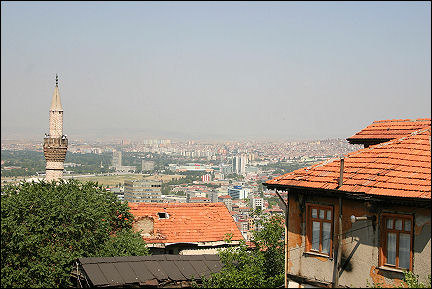
|
Once inside, it feels like a medieval city, with old houses, many dilapidated. The people who live here seem poor. We climb to the top, where we're actually on the walls themselves and look out over Ankara.
We drive back into town and park the car near the bus terminal, from where it is a short walk to Julianus' Column: a Roman column with a huge stork nest on top. Nearby is the temple of Augustus, virtually touching the 15th century mosque next to it. There seems to be a service in the mosque, so we leave.
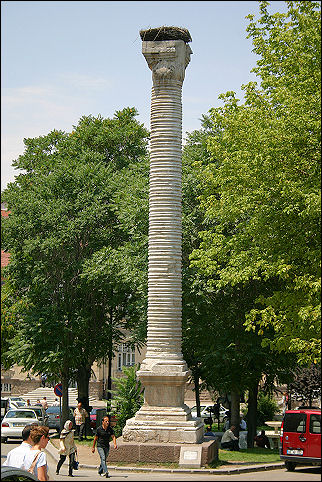
|
On the internet I discovered this morning that there is a synagogue in Ankara. We ask directions, but no one has ever heard of the street. We enter an official looking building and bump into a man who is just leaving on lunch break. He tells us he has just visited England and that he would love to take us to the address.
On the way it becomes clear that he doesn't have a clue where to find this street, but he keeps asking and people send us in different directions. Our route leads through a wonderful indoor market, a real bazar without souvenirs, but with meat and fish, fresh vegetables and fruit, clothing, fabrics, houseware and even a bakery.
Thanks to our helpful friend, we finally reach our destination.
It is a disappointment: the synagogue is surrounded by a high wall, the gate is locked and nobody is there. On the corner is a small, improvised police post.
Next morning we leave Ankara and take the highway to Istanbul. We plan to reach Thessaloniki in Greece today, but after ten hours of driving we decide to spend the night in Alexandroupoli, a sweet little seaside resort in the province of Thracia, with a promenade and only Greek tourists. We eat grilled sardines on a terrace near the sea.
Macedonia and Croatia
The road winds along high mountains and deep canyons
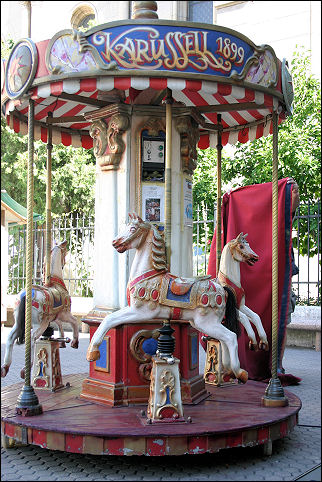
|
Today we pass Thessaloniki by: it looks unappealing. We continue to the Macedonian border, where I have to pay a lot of money because they find out that my car insurance papers are expired. I must have put the wrong papers in my wallet.
Macedonia is beautiful, especially the South: immediately after the border, the road follows a river that winds between green mountains. The mountains get higher and steeper as we continue on our way, until we reach a canyon. Exactly at this beautiful spot, a car lies overturned at the side of the road. We are not surprised: everywhere in this region, people drive like idiots, overtaking cars in bends.
We spend the night in the capital of Macedonia, Skopje, one of the ugliest cities I've ever seen. It has been totally ruined by communist architecture. Everything is grey and looks dilapidated. We find a hotel in a back street. It is moving to see how hard people are trying to make something out of their depressing surroundings. The hotel is being renovated and it is clear that the owners want it to be colorful and pretty. We have dinner in a nearby restaurant that has instant soup on its menu. It also has a "whine list."
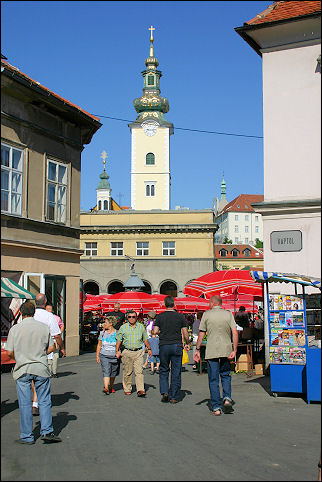
|
The next day we reach Zagreb, Croatia. To our astonishment, it is exactly the opposite of Skopje: the historical city center has been preserved very well. Our hotel is opposite a beautiful 19th century train station. This whole neighborhood is 19th century, as we find out when we walk via a beautiful park towards the old center, which is mainly 18th century.
In one of the oldest streets, which is the popular spot for evening promenades, we find a restaurant with terraces overlooking the street. While we enjoy one of the most excellent meals during this trip, we look at and comment on the passers-by below us.
Because we want to take more pictures next morning, we leave later than planned. We have lunch in Southern Austria, delicious, to my surprise and sleep in a motel in Southern Germany. The next day we arrive in Amsterdam. What a trip.